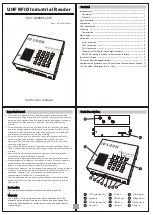
The I/O pins of serial bus are programmable. They can be
programmed as D/I, or D/O. Some pins can be configured to D/I
or D/O or timer input or timer output. There are many serial
interface devices today. The features of these serial devices are
given as follows:
Smaller size compared to parallel devices.
Lower cost compared to parallel devices.
Easier to design for isolation application.
The serial interface of an I/O expansion bus can link to these
serial devices very easily. The combination of serial & parallel
interface makes the I/O expansion bus very easy & powerful for
various industry applications. These are many design examples
given in this manual and all hardware circuit & software driver
sources are OPENING for all user. From these examples, the
users can buy these examples or modify them for their special
requirements. The system design steps are given as follows:
Step 1:
List all functions required.
Step 2:
For all functions, go to step 3. If all functions are solved
STOP.
Step 3:
If this function can be solved by the 7000 module
Go to
step 2 for next function.
Step 4:
If this function can be solved by 7188X+X???
Go to step
2 for next function.
Step 5:
Now user must design special hardware on the I/O
expansion bus.
Step 6:
User writes their special software driver based on this new
hardware.
Step 7:
Refer to
“7521/7522/7523/24/27 Software User’s manual”
for firmware. Modify & download this firmware into the CPU
module, this module now will work as a customized 7000
module.
Step 8:
Go to step 2 for next function.
After the above steps, user can combine the
standard-7000
modules
&
customized-7000 modules
to solve all applications
in the same RS-485 network. This customized solution diagram is
given as follows:
I/O Expansion Bus for 7188X/7188E User’s Manual, Jan/2005 v1.5, 7PH-000-15---7








































